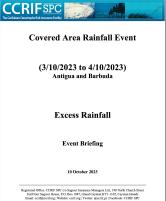 Event Briefing - Excess Rainfall - Covered Area Rainfall Event - Antigua and Barbuda - October 10, 2023
Event Briefing - Excess Rainfall - Covered Area Rainfall Event - Antigua and Barbuda - October 10, 2023 |
This event briefing describes the impact of rainfall in Antigua and Barbuda, which was associated with a Covered Area Rainfall Event (CARE), starting on 3 October and ending on 4 October 2023. |
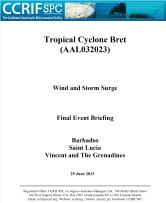 Final Event Briefing - TC Bret - Wind and Storm Surge - Barbados, Saint Lucia, St. Vincent and The Grenadines - June 25 2023
Final Event Briefing - TC Bret - Wind and Storm Surge - Barbados, Saint Lucia, St. Vincent and The Grenadines - June 25 2023 |
Tropical Storm Bret was the third named tropical cyclone of the 2023 Atlantic Hurricane Season. On 22 and 23 June, Bret passed over Barbados and the Windward Islands.Tropical-storm-force winds spread over Barbados, Saint Lucia and Saint Vincent and the Grenadines. At the time of writing this report, Bret was about to pass north of Aruba, Bonaire and Curacao, and was expected to dissipate within a few hours. |
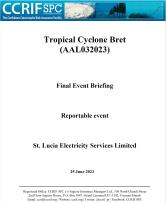 Final Event Briefing - TC Bret - Reportable Event - Saint Lucia Electricity Services Limited - June 25 2023
Final Event Briefing - TC Bret - Reportable Event - Saint Lucia Electricity Services Limited - June 25 2023 |
Tropical Storm Bret was the third named tropical cyclone of the 2023 Atlantic Hurricane Season. On 22 and 23 June, Bret passed over Barbados and the Windward Islands.Tropical-storm-force winds spread over Barbados, Saint Lucia and Saint Vincent and the Grenadines. At the time of writing this report, Bret was about to pass north of Aruba, Bonaire and Curacao, and was expected to dissipate in a few hours. |
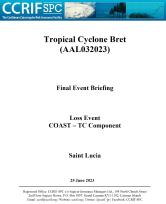 Final Event Briefing - TC Bret - Loss Event COAST - TC Component - Saint Lucia - June 25 2023
Final Event Briefing - TC Bret - Loss Event COAST - TC Component - Saint Lucia - June 25 2023 |
Tropical Storm Bret was the third named tropical cyclone of the 2023 Atlantic Hurricane Season. On 22 and 23 June, Bret passed over Barbados and the Windward Islands.Tropical-storm-force winds spread over Barbados, Saint Lucia and Saint Vincent and the Grenadines. At the time of writing this report, Bret was about to pass north of Aruba, Bonaire and Curacao, and was expected to dissipate in a few hours. |
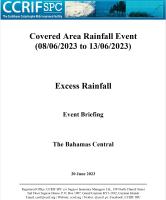 Event Briefing - Excess Rainfall - Covered Area Rainfall Event - The Bahamas - June 20 2023
Event Briefing - Excess Rainfall - Covered Area Rainfall Event - The Bahamas - June 20 2023 |
The Bahamas was affected by the newly formed Tropical Depression Two, resulting in adverse weather conditions from 8 to 13 June 2023. During this period, the heaviest rainfall occurred over the central areas of the country. |
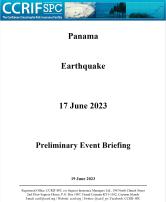 Preliminary Event Briefing - Earthquake - Panama - June 17 2023
Preliminary Event Briefing - Earthquake - Panama - June 17 2023 |
A magnitude 5.3 earthquake occurred at 04:58:17 (UTC) on 17 June 2023, 69.3 km (43.1 mi) N of Boca Chica, Chiriquí Province, Panama; 86.2 km (53.6 mi) N of Pedregal, Chiriquí Province and 91.6 (56.9 mi) N of Las Lomas, Chiriquí Province. Initial estimates from the United States Geological Survey (USGS) located the epicentre of the event at 7.608°N, 82.334°W, and at a depth of 16.9 km (10.5 mi). |
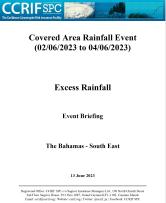 Event Briefing - Excess Rainfall - Covered Area Rainfall Event - The Bahamas - June 13 2023
Event Briefing - Excess Rainfall - Covered Area Rainfall Event - The Bahamas - June 13 2023 |
The Bahamas was affected by a newly formed Tropical Depression Two, resulting in adverse weather conditions from 2 to 4 June 2023. During this period, the heaviest rainfall occurred particularly over the southeast area. |
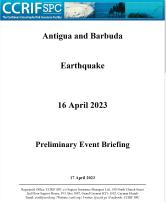 Preliminary Event Briefing - Earthquake - Antigua and Barbuda - April 16 2023
Preliminary Event Briefing - Earthquake - Antigua and Barbuda - April 16 2023 |
A magnitude 5.2 earthquake occurred at 09:49:51 (UTC) on 16 April 2023, 39.1 km (24.3 mi) SWS of Codrington, Barbuda, Antigua and Barbuda; 83.5 km (51.9 mi) SSW of Saint John, Antigua and Barbuda and 140.8 km (87.5 mi) WSW of Saint George Basseterre, Saint Kitts and Nevis. Initial estimates from the United States Geological Survey (USGS) located the epicentre of the event at 17.800°N, 61.508°W, and at a depth of 25.8 km (16.03 mi). |
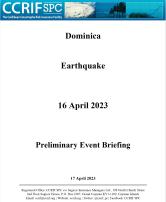 Preliminary Event Briefing - Earthquake -Dominica - April 16 2023
Preliminary Event Briefing - Earthquake -Dominica - April 16 2023 |
A magnitude 5.1 earthquake occurred at 11:22:21 (UTC) on 16 April 2023, 31.9 km (19.8 mi) S of Saint Andrew, Dominica; 3.5 km (2.2 mi) NNW of Grand-Bourg, Guadeloupe and 34.9 km (21.7 mi) NW of Capesterre-Belle-Eau, Guadeloupe. Initial estimates from the United States Geological Survey (USGS) located the epicentre of the event at 15.853°N, 61.306°W, and at a depth of 104.1 km (64.68 mi). |
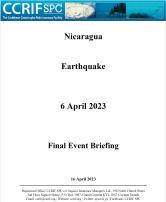 Final Event Briefing - Earthquake - Nicaragua - April 6 2023
Final Event Briefing - Earthquake - Nicaragua - April 6 2023 |
A magnitude 5.1 earthquake occurred at 06:39:06 (UTC) on 6 April 2023, 16.1 km (10 mi) SE of Moyogalpa, Nicaragua; 24 km (14.9 mi) S of Rivas, Nicaragua and 30.6 km (19 mi) WNW of Nandaime, Nicaragua. Final estimates from the United States Geological Survey (USGS) located the epicentre of the event at 11.650°N, 85.794°W, and at a depth of 10 km (6.2 mi). |

